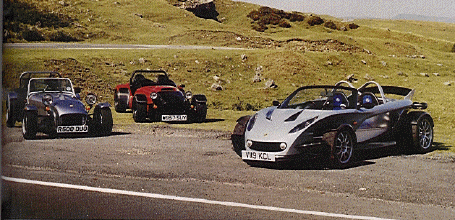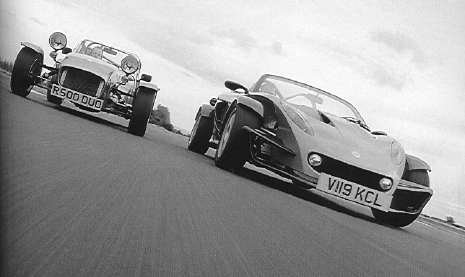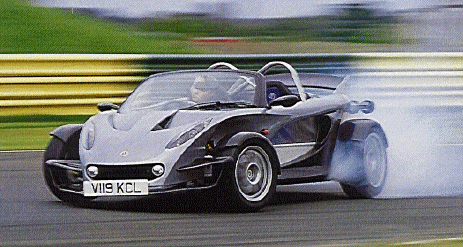Car Magazine
Performance Car of The Year - November 2000 issue
28 cars tested in different categories on both road and track - here we reproduce extracts
words by Mike Duff

Part
One – Three Lightweight Specials fight it out on the road
Caterham
Superlight R500 vs Lotus 340R
vs Westfield Megabusa
NATURE
. UP CLOSE AND PERSONAL. The
elements suddenly become very elemental when you don't have a roof or even a
windscreen. Stones and bugs
clatter and splatter your helmet, the wind finds icy chinks in your
waterproof armour. And if it
rains, you get very wet. indeed, climate control courtesy of God Himself.
Only once you've dealt with this sensory overload can you get to the speed.
The sheer, brutal, peripheral vision-blurring speed.
Focus on distant objects and watch them arrive, first class.
Welcome to the sharp end, welcome to the lightweight sports cars.
These
aren't machines for people who like their creature comforts.
Elsewhere in Performance Car Of The Year you'll find one-touch
electric windows and air-conditioning.
At least one dashboard-mounted TV.
Whereas between them our three lightweight contenders can muster
precisely one roof, two windscreens and no heaters.
But
then, there's the maths. Statistics
have rarely had such an obvious, physical relevance.
Three cars: Lotus 340R, Westfield Megabusa and Caterham Superlight
R500. Three figures:
291bhp/ton, 420bhp/ton and 500bhp/ton.
A Ferrari 360, no slouch, manages just 287bhp/ton.
The
Lotus 340R is obviously the softest here, at least a magnitude off in terms
of raw performance. But then it
has a windscreen and a cockpit you don't need to put on like a skin-tight
catsuit. In terms of bulk, the 340R is Elise Light, saving 56kg over a
111S. But in aspiration it's
Elise Plus, taking the reduce-it-to-the-max concept to its logical
conclusion. Clothed in the
super curvy Russell Carr-designed bodywork, it's also one of the most
visually daring cars of the last 12 months.
Maybe not quite beautiful, but certainly unlike anything else on the
roads.
Now
the mad house. First the
Westfield Megabusa: a super-lightweight sports car mated to a 185bhp Suzuki
Hayabusa motorbike engine, complete with six-speed sequential gearbox. It's overwhelming purpose is as a track car, but find the
wide open spaces and it's more than up to some rapid road use.
And there's absolutely nothing in the way of wussy creature comforts,
no windscreen and no weather protection.
With one exception, it's also the fastest production car on sale in
Britain today.
The
exception being our third contender: Caterham's utterly mad Superlight R500.
Leave the McLaren Fl out of the equation and the Caterham is the most
power-to-weight endowed road car in the world, ever.
Yet it's not been. done by rocket science, merely by turning up the
commitment of the existing components.
There's maximum weightsaving on the body and an almost unfeasible
230bhp coming from the 1.8-litre Rover K-series, reworked by Minster Race
Engines. Our test car carried
the optional windscreen and tonneau roof 'road pack'.
And
that's it. Lightweight cars,
and a lightweight PCOTY segment. There
was also meant to be an Ariel Atom here, but it went down to a freak
component failure. Acquaintance
will need to wait until later in the year.
FIRSTLY,
AND MOST IMPORTANTLY, HOW fast? These
were cars to bring out the small boy in even the most staid passers-by.
'What's the 0-60?' and 'How much flat out?' To which the replies
were, in order, 'not much' and 'plenty'.
Both Westfield and Caterham can, providing you don't fluff the start,
get to the distant side of 100mph in something under 10 seconds, the Lotus
maybe three or four seconds off them.
Not
that we did, of course. Indeed,
even finding the quietest, widest and generally most open roads that Wales
has to offer, we still couldn't do much more than brush the outer limits.
Full throttle acceleration was reserved like a tea-time treat in all
except the Lotus. The 340R's probably at
least 75 percent as fast as the other cars here, but from the cockpit you'd
swear it was less than hal£ It's relatively laid back and relaxed, even on
a 7800rpm redline mission. But
then, you need not treat the throttle like a loaded mouse trap, with only
very slow, very tight corners asking questions of the traction.
Out on the moors the engine, standard Elise mid-mounted K-series here
with 192bhp, becomes just another part of the all-round dynamic talent.
Whereas
in the Caterham and Westfield, the performance overshadows everything else.
Respect is a fairly critical part of your relationship with both
these cars, high-speed wheelspin stalking you like death itself should you
hit a bump or a contour, or simply be trying too hard.
Swapping between them, you'd swear the Hayabusa was the fastest, such
is the auditory barrage from the 1.3-litre engine.
There's trouble 'Moving off the line, due to the near total lack of
flywheel effect, but once you're rolling the engine's tractable from even
low speeds all the way to the 12k-ish red line.
And the noise grows, swells and comes alive accordingly, starting a
deep-chested burble, ending a full-on castrati
solo. The super-close gearbox ratios also enable you to do a
sampled loop of the top end for maximum sheep scaring.
The
Caterham speaks with a softer voice, but carries a bigger stick.
The engine and exhaust get loud and harsh at high revs, a purposeful
note, but not a pleasant one. But
empirically it draws ahead of the Westfield on side-by-side straights,
pulling out the yards at will.
That
is, providing you don't miss a shift. The
R500's six-speed box is built in-house by Caterham and we were warned that
we needed to be fairly brutal with it.
Even so, there's a distinct baulk moving between some of the ratios
if hurried. The Westfield's
sequential gearshift has no refinement at low speeds, and finding neutral or
getting reverse (inserting a special idler gear) is a nightmare.
But used at the limit, it becomes near instantaneous, the clutch
purely optional.
The
340R provides the perspective, with a non-abrasive, no bullshit gearchange
it's almost impossible to miss. Indeed,
the Lotus provides an object lesson in control tactonics with an absolutely
linear throttle, steady brake pedal and real-world proof clutch.
And sublime steering, slow compared to the others, but perfectly
proportioned - speeding up the more lock you put on. You also get to sit in comfort, and the depth of the
windscreen also helps keep off light showers providing you stay moving.
There's
no option how you sit in the Westfield or Caterham, so firmly are you
clamped in your designated hollow. The
Westfield's cockpit is slightly wider and ordinary shoes can contact one
pedal at a time. But in the
Caterham, the driver's footwell is almost impossibly tiny.
It's frighteningly easy to hit the throttle with the brake.
Steering
is the critical difference between R500 and Megabusa.
The Caterham's tiny wheel is unambiguous, passing your orders direct,
and trading it for near peerless feedback on what the front wheels are
thinking. It's a physical
process, especially at lower speeds, but it's an integral part of building
trust in the vehicle, realising that the default handling trait, certainly
below silly speeds, is understeer. Understeer
you can. dilute or cancel with an injection of horsepower.
The
Megabusa's helm is as fast, but less talkative.
Steering is light, and there's a surprising absence of feel,
especially in the period before the tyres warm up.
You know the car will corner at unfeasible velocities, but it's a
scientific assessment rather than a direct invitation.
Same
with suspension. Both Caterham
and Westfield have bare millimetres of wheel travel, to be handed out
reluctantly with a consequent lower back and kidney work over.
Yet the Caterham feels better stuck down, probably thanks to the near
perfect partnership between springs and dampers.
The Megabusa scrabbles for traction more, and feels slightly less
confident under braking. Retardation
is still huge, but you need to modulate efforts to prevent nasty tramlining.
A series of bumps also make the Westfield feel slightly up in the
air, crash absorption falling on the tyre walls.
So
where's the Lotus while all this is happening?
Probably a fair way down the road, but showering considerably more
praise on its driver. The 340R
is a silver-tongued master of feedback, keeping you in the loop and
generally asking your advice. And
reacting instantly to changes in input.
Unlike the Caterham, there's almost no understeer, at least, not this
side of ridiculous velocities. But
then, there's very little oversteer either (lifting off mid-comer provokes
only a non-intimidating twitch, nothing more).
The Lotus just gets the job done, no slip and no slop.
Suspension
is also a revelation on the Lotus. Despite
the extra mass, the unique Yokohama A038s are rivalling to take the outright
grip award. Add in the extra
mass, keeping the car closer to the road over bigger bumps, and the taut but
supple suspension really polishes the surface as you pass. And despite the excellent of the Westfield and Caterham's
brakes, the Lotus just pips retardation as well, burning off momentum
effortlessly and massively, even on wet moors roads.
In
short, you trust the Lotus and you feel that it trusts you; a symbiotic
driving relationship. It was
also the contender that Dai Public showed most attention to, and the comment
was overwhelmingly favourable. Caterham
and Westfield tended to fade into the background when stationary, met with
underwhelmed 'oh right' and 'I see' from bystanders appraised of their
talents.
And,
from a road section point of view, the Lotus also walks it.
It's not the fastest, but it's certainly fast enough.
A car whose limits you have a chance of exploring on an everyday
basis without the pesky inconvenience of funeral bills or standing contrite
in the dock. At £35,000 it's
certainly not cheap but almost all 340 examples have been sold, so
exclusivity is guaranteed. A
classic from the moment the concept was penned.
Leaving
the business of taking through our second contender to the track. Both Caterham and Westfield feel as if they'll become very
good indeed once there are run-off areas and a lack of oncoming sheep.
But we're assessing them here as road cars. And
there can be only one winner.
A
tricky call, certainly when value for money is called into the argument. At just £21,000, the Megabusa undercuts the R500 by a
massive £14,000. Indeed, you
could just about have it for the track and a second-hand Impreza for the
road.For the money, nothing with four wheels goes faster, and that includes
decommissioned racing cars and the like.
A true performance bargain.
The
Caterham is certainly the more polished product, but you are paying a
massive premium for it. It's
incredibly fast and even experienced drivers will find they need to perform
an apprenticeship before coming close to the outer limits.
In performance terms, this is the daddy; almost everything else is
out of the frame of reference.
But the Performance Car of the Year rules are unyielding, and with good reason. Value is only one of the categories here, and on almost everything else, the Caterham draws narrowly ahead. It's faster, it feels better lashed down and the capacity for unexpected frights is considerably less. The Westfield takes engine sound and cabin space, but on the core driving criteria, it lags behind. A close run thing, all the way to the line. But it's the Caterham that will be joining us at Croft.

Part
Two – The two contenders fight it out on the track
Lotus 340R vs Caterham Superlight R500
FOR
ME, THE DEFINING MOMENT OF THE track test was at the end.
Most of the CAR office were
on the pitwall, stories frozen in mid-expansion, jaws slack. Just one car was left on the track - the Caterham R500
Superlight. And one driver,
Peter Dumbreck, doing 'demonstration laps'.
It
was a car-control masterclass, as the Caterham is a truly ferocious device.
We knew that from the road, but it stays true on the track, and a
fair degree of intimidation remains. This
is a car you need to get your head around before you con exploit it.
Acceleration is monstrous, massive, brutal.
All that, yet somehow more. However
helmet-bangingly fast you remember it being, it always seems faster when you
get in again.
The
steering is almost too quick,
every millimetre of movement on the wheel having an immediate,
stomach-sloshing effect. Below
max attack this is good, helping you to dart around and pick your line to
the nearest pebble. But start
considering power oversteer and you need to be super-accurate first time
out, or risk something for worse.
The
steering's a bit quick to be honest,' said a surprised Kershaw, 'when you
start to correct it, you're using such tiny angles it all gets a bit
fishtailey.' A stark contrast to the lotus 340R, as unintimidating on the
track as it is on the road. It's
certainly fast, probably one of the fastest cars here lap-on-lap.
But the most surprising thing was the speed with which anybody could
get in and drive the car immediately, instinctively, right up to a very
close proximity with the limits.
The
interference of normal cars has been removed.
There's nothing between instructions and actions, inputs and outputs. Even the Ferrari and Porsche 911 felt somehow ponderous when
driven back-to-back with the 340.
Within
all this, the lotus's engine gets rather lost.
The K-series wails along merrily, but without the dramatic suddenness
of the Caterham.
Acceleration
was gauged more in terms of surprise at your corner arrival pace.
And
in terms of raw grip, honours were just about even.
Both cars were basically wearing cut sticks, and we're reasonably
glad it didn't rain. But in the
dry, adhesion was analogous to shit and blanket.
The Caterham's tyres needed to be warmed properly before they'd yield
their best, and even then the understeer that we'd noted on the road
remained.
'The
handling balance is actually quite neutral ' said Kershaw, ‘it washes into
understeer through the high-speed stuff.
And then when it goes sideways, you haven't got any mass behind the
rear, so you can just flick it, correct it, then get back on the power
again.'
The
Lotus' grip felt better balanced between front and rear.
The car remains planted, stuck and absolutely neutral up to massively
high speeds. Sideways was
definitely possible, as Kershaw gracefully proved, but it's really not in
keeping with the character of the car.
You'll go quicker and, as a driver, have more fun trimming, tucking
and nipping your way around the corners.
'It's
a little bit more agile than the Exige,' summarised Kershaw, 'you con have a
bit of a blast and it's easier to catch, because grip doesn't drop off.'
Brakes on both cars were a league ahead,. courtesy of little momentum and
tons of grip. The lack of ABS
didn't become an issue, although the Caterham's tiny cabin still caught out
those in hurried search of the middle pedal.
And the Lotus' mega-firm pedal also yielded slightly better feel as
to what was happening.
In
both cars you could comfortably leave the braking for Clervaux and Tower
maybe 20 yards later than in the Porsche 911, while maintaining similar
confidence levels.
On
the raw speed figures, the Caterham is champion, but it's always going to
dilute the delight with a bit of old-fashioned terror.
From an ordinary mortal point of view, the Lotus has to get the
laurels. It doesn't need to
frighten you to win your respect and the bond you create with it, on even
the slightest acquaintance, is
almost emotionally intense. As an interpretation of the ultimate Elise it works, for us, slightly
better than even the Exige. Which
is very high praise indeed.

Part Three – The results of Performance Car of The Year
1st : Porsche 911 Turbo
Equal 2nd : Lotus 340R & Ferrari 360 Modena
Two runners up. The 340R takes the Elise and runs with it. Day to day it's as useable as a pogo stick. You can't travel with luggage - buy a toothbrush when you arrive - and if it's raining you have to tog up like a trawlerman. You get amazingly little car for the money.
Since all those things were taken into account, there must have been other things that were pretty special about it by way of compensation.
If you ever get the chance to turn it's steering wheel or press its pedals, you'll know nothing else has to be said by way of justification.
Copyright Car magazine November 2000